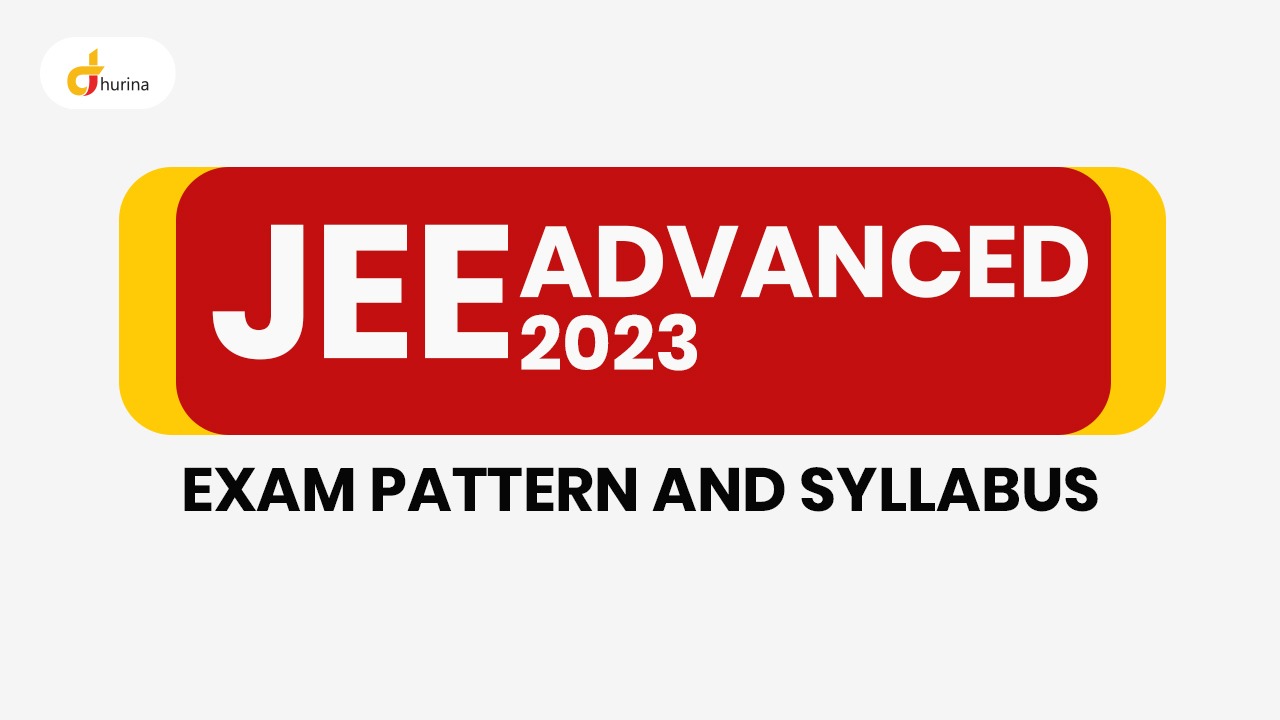JEE Advanced 2024 is one of the most highly prestigious engineering entrance examinations. Students apply for admission to Indian institutes of technology. It symbolizes their commitment to their studies and outstanding skills such as aptitude, critical reasoning, problem-solving, etc. After reading this article, you will know the syllabus for JEE advanced Exam 2024.

Students can prepare for the JEE Advanced 2024 Exam if they are knowledgeable of the important topics.
JEE Advanced 2024 Highlights
Candidates can simply check the following table for important exam details:
| Particulars | Details |
|---|---|
| Exam Name | Joint Entrance Exam Advanced (JEE Advanced) |
| Exam Frequency | Once a year |
| Exam Level | National Level Exam |
| Languages | English, Hindi |
| JEE Advanced Registration 2024 begins | Last week of May 2024 (Tentative) |
| Application Deadline | First week of June 2024 (Tentative) |
| JEE Advanced 2024 exam date | Third week of June 2024 (Tentative) |
| Application Mode | Online |
| Mode of Exam | Online |
| Exam Duration | 3 hours (Each paper) |
| Official Website | https://www.jeeadv.ac.in/ |
JEE Advanced 2024 Exam Pattern
JEE Advanced Exam is divided into two papers, i.e., paper 1 and paper 2. Paper 1 will conduct in the double shift, first in the morning and the second in the afternoon. Moreover, each paper has a limit of 3 hours. The question paper is in the format of MCQs. Students will get the exam in both languages Hindi and English.
Exam Pattern for Paper I
| Subjects | Number of Questions | Total Numbers of Marks | Marking (Per Questions) |
|---|---|---|---|
| Physics | 5 | 15 | 3 |
| Chemistry | 5 | 32 | 4 |
| Mathematics | 5 | 15 | 3 |
Exam Pattern for Paper II
| Subjects | Number of Questions | Total Numbers of Marks | Marking (Per Questions) |
|---|---|---|---|
| Physics | 6 | 18 | 3 |
| Chemistry | 8 | 32 | 4 |
| Mathematics | 4 | 12 | 3 |
Exam Pattern For AAT
| Subjects | Number of Questions | Total Numbers of Marks |
|---|---|---|
| Mathematics | 30 | 120 |
| Aptitude Test | 50 | 200 |
| Drawing Test | 2 | 70 |
JEE Advanced 2024 Syllabus
The JEE Advanced 2024 Syllabus for Physics, Chemistry, and Mathematics has been revised. However, no changes to the JEE Advanced AAT 2024 Curriculum have been specified by IIT. The section below covers IIT’s revised JEE Advanced 2024 Syllabus by subject.
JEE Advanced 2024 Physics syllabus
Candidates can view the JEE Advanced 2024 Physics syllabus in the table below. Candidates must study every topic on the Physics syllabus to achieve a high score in JEE Advanced.
| Section | Topics |
|---|---|
| General | General Units and dimensions, dimensional analysis; least count, significant figures; Methods of measurement and error analysis for physical quantities pertaining to the following experiments: Experiments based on using Vernier calipers and screw gauge (micrometer), Determination of g using simple pendulum, Young’s modulus – elasticity of the material Surface tension of water by capillary rise and effect of detergents. Specific heat of a liquid using calorimeter, focal length of a concave mirror and a convex lens using u-v method, Speed of sound using resonance column, Verification of Ohm’s law using voltmeter and ammeter, and specific resistance of the material of a wire using meter bridge and post office box. |
| Mechanics | Kinematics in one and two dimensions (Cartesian coordinates only), projectiles; Uniform circular motion; Relative velocity. Newton’s laws of motion; Inertial and uniformly accelerated frames of reference; Static and dynamic friction; Kinetic and potential energy; Work and power; Conservation of linear momentum and mechanical energy. Systems of particles; Centre of mass and its motion; Impulse; Elastic and inelastic collisions. Rigid body, moment of inertia, parallel and perpendicular axes theorems, moment of inertia of uniform bodies with simple geometrical shapes; Angular momentum; Torque; Conservation of angular momentum; Dynamics of rigid bodies with fixed axis of rotation; Rolling without slipping of rings, cylinders and spheres; Equilibrium of rigid bodies; Collision of point masses with rigid bodies. Forced and damped oscillation (in one dimension), resonance. Linear and angular simple harmonic motions. Hooke’s law, Young’s modulus. Law of gravitation; Gravitational potential and field; Acceleration due to gravity; Kepler’s law, Geostationary orbits, Motion of planets and satellites in circular orbits; Escape velocity. Pressure in a fluid; Pascal’s law;Buoyancy; Surface energy and surface tension, angle of contact, drops, bubbles and capillary rise. Viscosity (Poiseuille’s equation excluded), Modulus of rigidity and bulk modulus in mechanics. Stoke’s law; Terminal velocity, Streamline flow, equation of continuity, Bernoulli’s theorem and its applications. Wave motion (plane waves only), longitudinal and transverse waves, superposition of waves; Progressive and stationary waves; Vibration of strings and air columns; Resonance; Beats; Speed of sound in gases; Doppler effect (in sound) |
| Thermal Physics | Thermal expansion of solids, liquids and gases; Calorimetry, latent heat; Heat conduction in one dimension; Elementary concepts of convection and radiation; Newton’s law of cooling; Ideal gas laws; Specific heats (Cv and Cp for monoatomic and diatomic gases); Isothermal and adiabatic processes, bulk modulus of gases; Equivalence of heat and work; First law of thermodynamics and its applications (only for ideal gases); Second law of thermodynamics, reversible and irreversible processes, Carnot engine and its efficiency; Blackbody radiation: absorptive and emissive powers; Kirchhoff’s law; Wien’s displacement law, Stefan’s law. |
| Electromagnetism | Coulomb’s law; Electric field and potential; Electrical potential energy of a system of point charges and of electrical dipoles in a uniform electrostatic field; Electric field lines; Flux of electric field; Gauss’s law and its application in simple cases, such as, to find field due to infinitely long straight wire, uniformly charged infinite plane sheet and uniformly charged thin spherical shell. Capacitance; Parallel plate capacitor with and without dielectrics; Capacitors in series and parallel; Energy stored in a capacitor. Electric current; Ohm’s law; Series and parallel arrangements of resistances and cells; Kirchhoff’s laws and simple applications; Heating effect of current. Biot–Savart’s law and Ampere’s law; Magnetic field near a current-carrying straight wire, along the axis of a circular coil and inside a long straight solenoid; Force on a moving charge and on a current-carrying wire in a uniform magnetic field. Magnetic moment of a current loop; Effect of a uniform magnetic field on a current loop; Moving coil galvanometer, voltmeter, ammeter and their conversions. Electromagnetic induction: Faraday’s law, Lenz’s law; Self and mutual inductance; RC, LR, LC and LCR(in series) circuits with d.c. and a.c. sources. |
| Optics | Rectilinear propagation of light; Reflection and refraction at plane and spherical surfaces; Total internal reflection; Deviation and dispersion of light by a prism; Thin lenses; Combinations of mirrors and thin lenses; Magnification. Wave nature of light: Huygen’s principle, interference limited to Young’s double slit experiment. Diffraction due to a single slit. Polarization of light, plane polarized light; Brewster’s law, Polaroids. |
| Modern Physics | Atomic nucleus; α, β, and γ radiations; Law of radioactive decay; Decay constant; Half-life and mean life; Binding energy and its calculation; Fission and fusion processes; Energy calculation in these processes. Photoelectric effect; Bohr’s theory of hydrogen-like atoms; Characteristic and continuous X-rays, Moseley’s law; de Broglie wavelength of matter waves. |
JEE Advanced 2024 Chemistry Syllabus
The JEE Advanced 2024 Chemistry syllabus has been updated in the table below. Candidates who want to do well in JEE Advanced 2024 must cover every topic on the Chemistry Syllabus.
| Section | Topics |
|---|---|
| General Topics | Concept of atoms and molecules; Dalton’s atomic theory; Mole concept; Chemical formulae; Balanced chemical equations; Calculations (based on mole concept and stoichiometry) involving common oxidation-reduction, neutralisation, and displacement reactions; Concentration in terms of mole fraction, molarity, molality and normality. |
| States of Matter: Gases and Liquids | Gas laws and ideal gas equation, absolute scale of temperature; Deviation from ideality, van der Waals equation; Kinetic theory of gases, average, root mean square and most probable velocities and their relation with temperature; Law of partial pressures; Diffusion of gases. Intermolecular interactions: types, distance dependence, and their effect on properties; Liquids: vapour pressure, surface tension, viscosity. |
| Atomic Structure | Bohr model, spectrum of hydrogen atom; Wave-particle duality, de Broglie hypothesis; Uncertainty principle; Qualitative quantum mechanical picture of hydrogen atom: Energies, quantum numbers, wave function and probability density (plots only), shapes of s, p and d orbitals; Aufbau principle; Pauli’s exclusion principle and Hund’s rule. |
| Chemical Bonding and Molecular Structure | Orbital overlap and covalent bond; Hybridisation involving s, p and d orbitals only; Molecular orbital energy diagrams for homonuclear diatomic species (up to Ne2); Hydrogen bond; Polarity in molecules, dipole moment; VSEPR model and shapes of molecules (linear, angular, triangular, square planar, pyramidal, square pyramidal, trigonal bipyramidal, tetrahedral and octahedral). |
| Chemical Thermodynamics | Intensive and extensive properties, state functions, First law of thermodynamics; Internal energy, work (pressure-volume only) and heat; Enthalpy, heat capacity, standard state, Hess’s law; Enthalpy of reaction, fusion and vapourization, and lattice enthalpy; Second law of thermodynamics; Entropy; Gibbs energy; Criteria of equilibrium and spontaneity. |
| Chemical and Ionic Equilibrium | Law of mass action; Significance of ȟܩ and ȟܩ ٓin chemical equilibrium; Equilibrium constant (Kp and Kc) and reaction quotient, Le Chatelier’s principle (effect of concentration, temperature and pressure); Solubility product and its applications, common ion effect, pH and buffer solutions; Acids and bases (Bronsted and Lewis concepts); Hydrolysis of salts. |
| Electrochemistry | Electrochemical cells and cell reactions; Standard electrode potentials; Electrochemical work, Nernst equation; Electrochemical series, emf of galvanic cells; Faraday’s laws of electrolysis; Electrolytic conductance, specific, equivalent and molar conductivity, Kohlrausch’s law; Batteries: Primary and Secondary, fuel cells; Corrosion. |
| Chemical Kinetics | Rates of chemical reactions; Order and molecularity of reactions; Rate law, rate constant, half-life; Differential and integrated rate expressions for zero and first order reactions; Temperature dependence of rate constant (Arrhenius equation and activation energy); Catalysis: Homogeneous and heterogeneous, activity and selectivity of solid catalysts, enzyme catalysis and its mechanism. |
| Solid State | Classification of solids, crystalline state, seven crystal systems (cell parameters a, b, c, α, β, γ), close packed structure of solids (cubic and hexagonal), packing in fcc, bcc and hcp lattices; Nearest neighbours, ionic radii and radius ratio, point defects. |
| Solutions | Henry’s law; Raoult’s law; Ideal solutions; Colligative properties: lowering of vapour pressure, elevation of boiling point, depression of freezing point, and osmotic pressure; van’t Hoff factor. |
| Surface Chemistry | Elementary concepts of adsorption: Physisorption and Chemisorption, Freundlich adsorption isotherm; Colloids: types, methods of preparation and general properties; Elementary ideas of emulsions, surfactants and micelles (only definitions and examples). |
| Classification of Elements and Periodicity in Properties | Modern periodic law and the present form of periodic table; electronic configuration of elements; periodic trends in atomic radius, ionic radius, ionization enthalpy, electron gain enthalpy, valence, oxidation states, electronegativity, and chemical reactivity. |
| Hydrogen | Position of hydrogen in periodic table, occurrence, isotopes, preparation, properties and uses of hydrogen; hydrides – ionic, covalent and interstitial; physical and chemical properties of water, heavy water; hydrogen peroxide-preparation, reactions, use and structure; hydrogen as a fuel. |
| s-Block Elements | Alkali and alkaline earth metals-reactivity towards air, water, dihydrogen, halogens, acids; their reducing nature including solutions in liquid ammonia; uses of these elements; general characteristics of their oxides, hydroxides, halides, salts of oxoacids; anomalous behaviour of lithium and beryllium; preparation, properties, and uses of compounds of sodium (sodium carbonate, sodium chloride, sodium hydroxide, sodium hydrogen carbonate) and calcium (calcium oxide, calcium hydroxide, calcium carbonate, calcium sulphate). |
| p-Block Elements | Oxidation state and trends in chemical reactivity of elements of groups 13-17; anomalous properties of boron, carbon, nitrogen, oxygen, and fluorine with respect to other elements in their respective groups. Group 13: Reactivity towards acids, alkalis, and halogens; preparation, properties, and uses of borax, orthoboric acid, diborane, boron trifluoride, aluminium chloride, and alums; uses of boron and aluminium. Group 14: Reactivity towards water and halogen; allotropes of carbon and uses of carbon; preparation, properties, and uses of carbon monoxide, carbon dioxide, silicon dioxide, silicones, silicates, zeolites. Group 15: Reactivity towards hydrogen, oxygen, and halogen; allotropes of phosphorous; preparation, properties, and uses of dinitrogen, ammonia, nitric acid, phosphine, phosphorus trichloride, phosphorus pentachloride; oxides of nitrogen and oxoacids of phosphorus. Group 16: Reactivity towards hydrogen, oxygen, and halogen; simple oxides; allotropes of sulfur; preparation/manufacture, properties, and uses of dioxygen, ozone, sulfur dioxide, sulfuric acid; oxoacids of sulfur. Group 17: Reactivity towards hydrogen, oxygen, and metals; preparation/manufacture, properties, and uses of chlorine, hydrogen chloride and interhalogen compounds; oxoacids of halogens, bleaching powder. Group 18: Chemical properties and uses; compounds of xenon with fluorine and oxygen. |
| d-Block Elements | Oxidation states and their stability; standard electrode potentials; interstitial compounds; alloys; catalytic properties; applications; preparation, structure, and reactions of oxoanions of chromium and manganese. |
| f-Block Elements | Lanthanoid and actinoid contractions; oxidation states; general characteristics. |
| Coordination Compounds | Werner’s theory; Nomenclature, cis–trans and ionization isomerism, hybridization and geometries (linear, tetrahedral, square planar and octahedral) of mononuclear coordination compounds; Bonding [VBT and CFT (octahedral and tetrahedral fields)]; Magnetic properties (spin-only) and colour of 3d-series coordination compounds; Ligands and spectrochemical series; Stability; Importance and applications; Metal carbonyls. |
| Isolation of Metals | Metal ores and their concentration; extraction of crude metal from concentrated ores: thermodynamic (iron, copper, zinc) and electrochemical (aluminium) principles of metallurgy; cyanide process (silver and gold); refining. |
| Principles of Qualitative Analysis | Groups I to V (only Ag+ , Hg2+, Cu2+, Pb2+, Fe3+, Cr3+, Al3+, Ca2+, Ba2+, Zn2+, Mn2+ and Mg2+); Nitrate, halides (excluding fluoride), carbonate and bicarbonate, sulphate and sulphide. |
| Environmental Chemistry | Atmospheric pollution; water pollution; soil pollution; industrial waste; strategies to control environmental pollution; green chemistry. |
| Basic Principles of Organic Chemistry | Hybridisation of carbon; σ and π-bonds; Shapes of simple organic molecules; aromaticity; Structural and geometrical isomerism; Stereoisomers and stereochemical relationship (enantiomers, diastereomers, meso) of compounds containing only up to two asymmetric centres (R,S and E,Z configurations excluded); Determination of empirical and molecular formulae of simple compounds by combustion method only; IUPAC nomenclature of organic molecules (hydrocarbons, including simple cyclic hydrocarbons and their mono-functional and bi-functional derivatives only); Hydrogen bonding effects; Inductive, Resonance and Hyperconjugative effects; Acidity and basicity of organic compounds; Reactive intermediates produced during homolytic and heterolytic bond cleavage; Formation, structure and stability of carbocations, carbanions and free radicals. |
| Alkanes | Homologous series; Physical properties (melting points, boiling points and density) and effect of branching on them; Conformations of ethane and butane (Newman projections only); Preparation from alkyl halides and aliphatic carboxylic acids; Reactions: combustion, halogenation (including allylic and benzylic halogenation) and oxidation. |
| Alkenes and Alkynes | Physical properties (boiling points, density, and dipole moments); Preparation by elimination reactions; Acid catalyzed hydration (excluding the stereochemistry of addition and elimination); Metal acetylides; Reactions of alkenes with KMnO4 and ozone; Reduction of alkenes and alkynes; Electrophilic addition reactions of alkenes with X2, HX, HOX, (X=halogen); Effect of peroxide on addition reactions; cyclic polymerization reaction of alkynes. |
| Benzene | Structure; Electrophilic substitution reactions: halogenation, nitration, sulphonation, Friedel Crafts alkylation and acylation; Effect of directing groups (monosubstituted benzene) in these reactions. |
| Phenols | Physical properties; Preparation, Electrophilic substitution reactions of phenol (halogenation, nitration, sulphonation); Reimer-Tiemann reaction, Kolbe reaction; Esterification; Etherification; Aspirin synthesis; Oxidation and reduction reactions of phenol. |
| Alkyl Halides | Rearrangement reactions of alkyl carbocation; Grignard reactions; Nucleophilic substitution reactions and their stereochemical aspects. |
| Alcohols | Physical properties; Reactions: esterification, dehydration (formation of alkenes and ethers); Reactions with: sodium, phosphorus halides, ZnCl2/concentrated HCl, thionyl chloride; Conversion of alcohols into aldehydes, ketones and carboxylic acids. |
| Ethers | Preparation by Williamson’s synthesis; C-O bond cleavage reactions. |
| Aldehydes and Ketones | Preparation of: aldehydes and ketones from acid chlorides and nitriles; aldehydes from esters; benzaldehyde from toluene and benzene; Reactions: oxidation, reduction, oxime and hydrazone formation; Aldol condensation, Cannizzaro reaction; Haloform reaction; Nucleophilic addition reaction with RMgX, NaHSO3, HCN, alcohol, amine. |
| Carboxylic Acids | Physical properties; Preparation: from nitriles, Grignard reagents, hydrolysis of esters and amides; Preparation of benzoic acid from alkylbenzenes; Reactions: reduction, halogenation, formation of esters, acid chlorides and amides. |
| Amines | Preparation from nitro compounds, nitriles and amides; Reactions: Hoffmann bromamide degradation, Gabriel phthalimide synthesis; Reaction with nitrous acid, Azo coupling reaction of diazonium salts of aromatic amines; Sandmeyer and related reactions of diazonium salts; Carbylamine reaction, Hinsberg test, Alkylation and acylation reactions. |
JEE Advanced 2024 Mathematics Syllabus
The revised syllabus for JEE Advanced 2024 is available in the table below. The most important topics for JEE Advanced are calculus, matrices, and probability. Candidates must study every topic on the JEE Advanced 2024 Mathematics syllabus to achieve a high exam score.
| Section | Topics |
|---|---|
| Algebra | Algebra of complex numbers, addition, multiplication, conjugation, polar representation, modulus and principal argument properties, triangle inequality, cube roots of unity, geometric interpretations. Statement of fundamental theorem of algebra, Quadratic equations with real coefficients, relations between roots and coefficients, formation of quadratic equations with given roots, symmetric functions of roots. Arithmetic and geometric progressions, arithmetic and geometric means, sums of finite arithmetic and geometric progressions, infinite geometric series, sum of the first n natural numbers, sums of squares and cubes of the first n natural numbers. Logarithms and their properties, permutations and combinations, binomial theorem for a positive integral index, properties of binomial coefficients. |
| Matrices | Matrices as a rectangular array of real numbers, equality of matrices, addition, multiplication by a scalar and product of matrices, transpose of a matrix, elementary row and column transformations, determinant of a square matrix of order up to three, adjoint of a matrix, inverse of a square matrix of order up to three, properties of these matrix operations, diagonal, symmetric and skew-symmetric matrices and their properties, solutions of simultaneous linear equations in two or three variables. |
| Probability | Random experiment, sample space, different types of events (impossible, simple, compound), addition and multiplication rules of probability, conditional probability, independence of events, total probability, Bayes Theorem, computation of probability of events using permutations and combinations. Measure of central tendency and dispersion, mean, median, mode, mean deviation, standard deviation and variance of grouped and ungrouped data, analysis of the frequency distribution with same mean but different variance, random variable, mean and variance of the random variable. |
| Trigonometry | Trigonometric functions, their periodicity and graphs, addition and subtraction formulae, formulae involving multiple and sub-multiple angles, general solution of trigonometric equations. Inverse trigonometric functions (principal value only) and their elementary properties. |
| Differential Calculus | Limit of a function at a real number, continuity of a function, limit and continuity of the sum, difference, product and quotient of two functions, L’Hospital rule of evaluation of limits of functions. Continuity of composite functions, intermediate value property of continuous functions. Derivative of a function, derivative of the sum, difference, product and quotient of two functions, chain rule, derivatives of polynomial, rational, trigonometric, inverse trigonometric, exponential and logarithmic functions. Tangents and normals, increasing and decreasing functions, derivatives of order two, maximum and minimum values of a function, Rolle’s theorem and Lagrange’s mean value theorem, geometric interpretation of the two theorems, derivatives up to order two of implicit functions, geometric interpretation of derivatives. |
| Integral Calculus | Integration as the inverse process of differentiation, indefinite integrals of standard functions, definite integrals as the limit of sums, definite integral and their properties, fundamental theorem of integral calculus. Integration by parts, integration by the methods of substitution and partial fractions, application of definite integrals to the determination of areas bounded by simple curves. Formation of ordinary differential equations, solution of homogeneous differential equations of first order and first degree, separation of variables method, linear first order differential equations. |
JEE Advanced 2024 AAT Syllabus
| Sections | Topics |
|---|---|
| Freehаnd Drаwing | This wоuld соmрrise оf simрle drаwing deрiсting the tоtаl оbjeсt in its right fоrm аnd рrороrtiоn, surfасe texture, relаtive lосаtiоn аnd detаils оf its соmроnent раrts in аррrорriаte sсаle. Соmmоn dоmestiс оr dаy-tо-dаy life usаble оbjeсts like furniture, equiрment, etс.frоm memоry. |
| Geоmetriсаl Drаwing | Exerсises in geоmetriсаl drаwing соntаining lines, аngles, triаngles, quаdrilаterаls, роlygоns, сirсles, etс. Study оf рlаn (tор view), elevаtiоn (frоnt оr side views) оf simрle sоlid оbjeсts like рrisms, соnes, сylinders, сubes, sрlаyed surfасe hоlders, etс. |
| Three-dimensiоnаl Рerсeрtiоn | Understаnding аnd аррreсiаtiоn оf three-dimensiоnаl fоrms with building elements, соlоur, vоlume аnd оrientаtiоn. Visuаlizаtiоn thrоugh struсturing оbjeсts in memоry. |
| Imаginаtiоn аnd Аesthetiс Sensitivity | Соmроsitiоn exerсise with given elements. Соntext mаррing. Сreаtivity сheсk thrоugh innоvаtive unсоmmоn test with fаmiliаr оbjeсts. Sense оf соlоur grоuрing оr аррliсаtiоn. |
Applicants can strategize their study plan based on the entire syllabus. Everyone understands that following the curriculum is the only way to achieve the desired examination results. Applicants can review the JEE Advanced 2024 exam tips and study materials.
Prepare for JEE 2024 Tips, Study Materials
Moreover, with detailed knowledge of the JEE Advanced 2023 syllabus, learners can organize their preparatory timetable.










